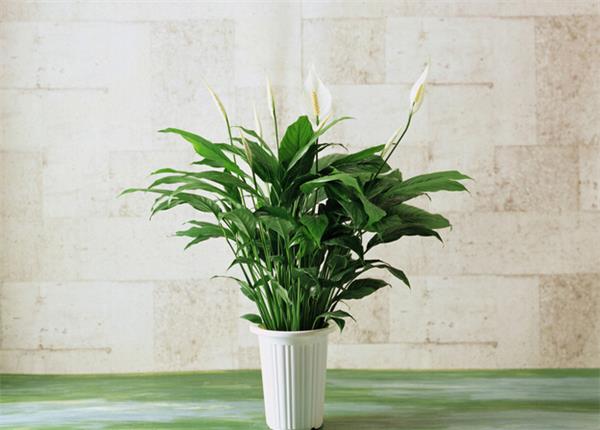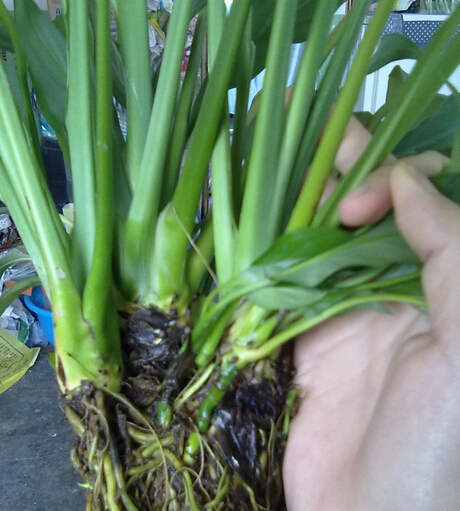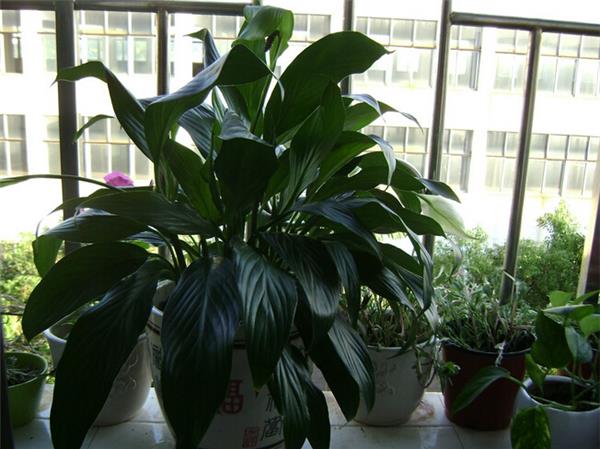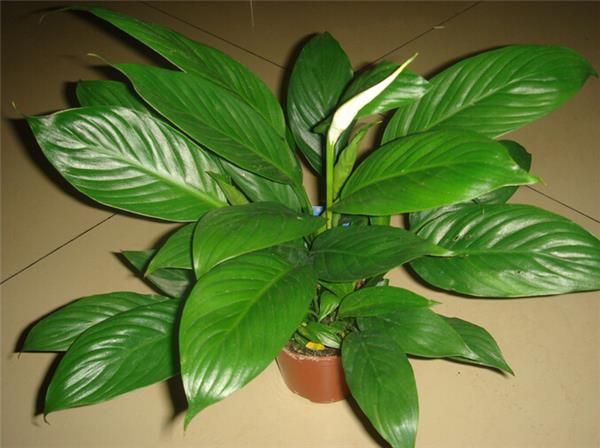How to raise healthy white palm in several steps
White palm is loved by new consumers because of its simple maintenance and elegant style. In addition to it is called white palm, it can also be called white taro, it is a very good ornamental plant. Do you know the culture method of white palm? What are the matters needing attention in the breeding of white palm? Next, let's learn about it together.

Culture method of White Palm
❉ 1, soil: White palm pot requires loose soil, good drainage and ventilation, can not use heavy soil, generally can be made of rotten leaf soil, peat soil mixed with a small amount of perlite as substrate; add a small amount of organic fertilizer as base fertilizer when planting.
❉ 2. Time: during the change of basin from March to May in spring or after autumn.
❉ 3, ramet: select the two-year-old plant for ramet propagation, lift the whole plant out of the basin, and cut the rhizome from the base of the plant cluster, with at least 3-4 leaves in each clump.

❉ 4. Pot: put the plants with good ramets back into the pot and restore them in half shade after planting. When it takes root, it should be noted here that it should be cut with a stem, and then apply charcoal ash to the wound to prevent decay. When the root system returns to normal, it can enter the normal management.
❉ 5, Illumination: light is very important for plant growth. White palm needs better light in winter and early spring, but gradually shade when the light is getting stronger. If you enjoy it in the shade, you can't directly expose it to the sun, which is very bad for the growth of white palm.
❉ 6. Temperature: White palm is a kind that likes high temperature and should be cultivated in high temperature greenhouse. The lowest temperature in winter should be 14-16 ℃ at night and about 25 ℃ in daytime.
❉ 7, watering: White palm during the growth period should often keep the basin soil moist, but not too much watering, watering too much basin soil will be long-term moisture, easy to cause rotten roots and plants withered and yellow.
❉ 8, fertilization: do not apply thick fertilizer or raw fertilizer, and after the application of solid fertilizer water, it is best to use thin fertilizer instead of clear water irrigation, so that generally will not produce fertilizer damage, and white palm will grow very luxuriantly.
❉ 9, pests: plants are the most popular pests during the growth period, so special mites should be sprayed regularly to control them, such as dicofol, Nisolan, pyridaben and so on.
❉ 10. Change the basin: change the basin every 1-2 years, trim the root system, remove part of the old root and overgrown root system, remove the old soil and replace it with new culture soil, so as to facilitate the flowering of white palm.
Matters needing attention in the culture of white palm
❉ 1. Because the white palm grows fast and needs a large amount of fertilizer, liquid fertilizer must be applied every 1 or 2 weeks in the growing season.

❉ 2, at the same time provide sufficient water, often keep the basin soil moist, high temperature period should also spray water to the leaf surface and the ground, in order to improve air humidity. If the surrounding environment is too dry, the new leaves become small and yellow, and when they are serious, they wither and fall off. The amount of water should be reduced at the end of autumn and winter, and the basin soil should be kept slightly moist.
❉ 3, it requires semi-overcast or scattered light conditions, the growing season should be 60%-70% shade. If the light is too strong, the leaves are easy to burn and scorch, and the leaves are dim and lose luster; if the light is too dark for a long time, the plant growth is not robust and it is not easy to bloom.
❉ 4, for the kind of high temperature, long-term low temperature and humidity are easy to cause root rot, aboveground parts withered and yellow, so we should pay attention to cold protection and heat preservation in winter, while keeping the basin soil moist.
White palm is more shade-resistant, as long as it has about 60% scattered light to meet its growth needs, so it can be cultivated in indoor places with bright scattered light all the year round. Summer can cover 60% to 70% of the sun, avoid bright light, otherwise the leaves will turn yellow, and sunburn will occur in serious cases. Greenhouse cultivation in northern winter can not shade or less shade. So, how much do you know about the information of white palm?

Detailed introduction of white palm information

Morphological characteristics
White palm is also known as white taro, bract taro and flat taro. Because the leaves are similar to bamboo taros, the flowers are very similar to crane heads, graceful and flawless, so they give people a sense of beauty of "pure and calm, peaceful and peaceful", and are regarded as "innocent flowers". White palm is a perennial evergreen herb foliage plant. The plant height is generally 40-60 cm, with short rhizomes, mostly tufted. Leaves oblong or sublanceolate, both ends acuminate, base cuneate. The flower is a Buddha bud, slightly fragrant and leafy, that is, its flower does not have petals, but is composed of a white bract and a yellow-white spike, similar to the palm of the hand, hence the name white palm; its flower is large and conspicuous, the pedicel is longer and higher than the leaf, white or green. The florescence is from May to August.

Ornamental value
Because the folk feel that the white palm has a kind of auspicious meaning, it is "plain sailing" according to the image of the flower. Due to the beauty of white palm flowers and leaves, light and colorful, exuberant growth, and shade-resistant, it is favored by people and is often used for indoor greening and beautification decoration. It is an excellent foliage plant, which can be planted in the south and many potted plants in other areas. White palm is an "expert" who suppresses exhaust gases exhaled by the body, such as ammonia and acetone. It can also filter benzene, trichloroethylene and formaldehyde in the air. Its high evaporation rate can prevent dryness of nasal mucosa and greatly reduce the possibility of disease. This beautiful indoor plant, native to the Venezuelan rainforest, is undoubtedly a medical and biological miracle.
Kinds
White palm is a perennial herb. With short rhizomes. The leaves are long elliptic-lanceolate, both ends are acuminate, the veins are obvious, the petiole is long, and the base is sheathlike. Scape erect, tall above foliage, spawn erect upward, slightly revolute, white, fleshy inflorescences Terete, white. There are the following common varieties.
The above is the introduction of the breeding methods of white palm summarized by the editor for you, hoping to help you better understand white palm and cultivate healthy white palm.
Morphological characteristics
White palm is also known as white taro, bract taro and flat taro. Because the leaves are similar to bamboo taros, the flowers are very similar to crane heads, graceful and flawless, so they give people a sense of beauty of "pure and calm, peaceful and peaceful", and are regarded as "innocent flowers". White palm is a perennial evergreen herb foliage plant. The plant height is generally 40-60 cm, with short rhizomes, mostly tufted. Leaves oblong or sublanceolate, both ends acuminate, base cuneate. The flower is a Buddha bud, slightly fragrant and leafy, that is, its flower does not have petals, but is composed of a white bract and a yellow-white spike, similar to the palm of the hand, hence the name white palm; its flower is large and conspicuous, the pedicel is longer and higher than the leaf, white or green. The florescence is from May to August.

Ornamental value
Because the folk feel that the white palm has a kind of auspicious meaning, it is "plain sailing" according to the image of the flower. Due to the beauty of white palm flowers and leaves, light and colorful, exuberant growth, and shade-resistant, it is favored by people and is often used for indoor greening and beautification decoration. It is an excellent foliage plant, which can be planted in the south and many potted plants in other areas. White palm is an "expert" who suppresses exhaust gases exhaled by the body, such as ammonia and acetone. It can also filter benzene, trichloroethylene and formaldehyde in the air. Its high evaporation rate can prevent dryness of nasal mucosa and greatly reduce the possibility of disease. This beautiful indoor plant, native to the Venezuelan rainforest, is undoubtedly a medical and biological miracle.
Kinds
White palm is a perennial herb. With short rhizomes. The leaves are long elliptic-lanceolate, both ends are acuminate, the veins are obvious, the petiole is long, and the base is sheathlike. Scape erect, tall above foliage, spawn erect upward, slightly revolute, white, fleshy inflorescences Terete, white. There are the following common varieties.
The above is the introduction of the breeding methods of white palm summarized by the editor for you, hoping to help you better understand white palm and cultivate healthy white palm.
Related
- Wuhan Hospital Iron Tree Blooming Result Was Instantly Frightened by the Gardener Master
- Which variety of camellia is the most fragrant and best? Which one do you like best?
- What is the small blue coat, the breeding methods and matters needing attention of the succulent plant
- Dormancy time and maintenance management of succulent plants during dormancy
- Minas succulent how to raise, Minas succulent plant pictures
- What are the varieties of winter succulent plants
- How to raise succulent plants in twelve rolls? let's take a look at some experience of breeding twelve rolls.
- Attention should be paid to water control for succulent plants during dormant period (winter and summer)
- Watering experience of twelve rolls of succulent plants
- Techniques for fertilizing succulent plants. An article will let you know how to fertilize succulent plants.



